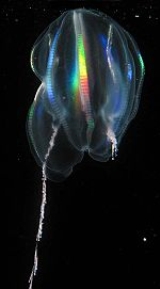
Tentaculata
Encyclopedia
Tentaculata is a class of comb jellies. The common feature of this class is a pair of long, feathery, contractile tentacle
s, which can be retracted into specialised ciliated
sheaths. In some species, the primary tentacles are reduced and they have smaller, secondary tentacles. The tentacles have colloblast
s, which are sticky-tipped cells that trap small prey.
Body size and shape varies widely. The group includes the small, oval sea gooseberries (genus Pleurobrachia
), found on both Atlantic and Pacific coasts. The more flattened species of the genus Mnemiopsis, about 4 inches long (10 cm), are common on the upper Atlantic coast; it has a large mouth and mainly feeds on larval molluscs and copepod
s. This species is brilliantly luminescent
. The similar, but larger, genus Leucothea
is abundant on the Pacific coast. Venus' girdle (genus Cestum) is a flattened, ribbon-like form reaching over 3 feet (90 cm) in length, and found in tropical waters.
Tentacle
A tentacle or bothrium is one of usually two or more elongated flexible organs present in animals, especially invertebrates. The term may also refer to the hairs of the leaves of some insectivorous plants. Usually, tentacles are used for feeding, feeling and grasping. Anatomically, they work like...
s, which can be retracted into specialised ciliated
Cilium
A cilium is an organelle found in eukaryotic cells. Cilia are slender protuberances that project from the much larger cell body....
sheaths. In some species, the primary tentacles are reduced and they have smaller, secondary tentacles. The tentacles have colloblast
Colloblast
Colloblasts are a cell type found in ctenophores. They are widespread in the tentacles of these animals and are used to capture prey. Colloblasts consist of a coiled spiral filament that is embedded in the epidermis and an axial filament with a granular dome. The apical surface of these cells...
s, which are sticky-tipped cells that trap small prey.
Body size and shape varies widely. The group includes the small, oval sea gooseberries (genus Pleurobrachia
Pleurobrachia
Pleurobrachia is a common genus of Ctenophora, containing the following species:*Pleurobrachia arctica Wagner, 1885*Pleurobrachia australis *Pleurobrachia bachei L...
), found on both Atlantic and Pacific coasts. The more flattened species of the genus Mnemiopsis, about 4 inches long (10 cm), are common on the upper Atlantic coast; it has a large mouth and mainly feeds on larval molluscs and copepod
Copepod
Copepods are a group of small crustaceans found in the sea and nearly every freshwater habitat. Some species are planktonic , some are benthic , and some continental species may live in limno-terrestrial habitats and other wet terrestrial places, such as swamps, under leaf fall in wet forests,...
s. This species is brilliantly luminescent
Bioluminescence
Bioluminescence is the production and emission of light by a living organism. Its name is a hybrid word, originating from the Greek bios for "living" and the Latin lumen "light". Bioluminescence is a naturally occurring form of chemiluminescence where energy is released by a chemical reaction in...
. The similar, but larger, genus Leucothea
Leucothea
In Greek mythology, Leucothea , "white goddess") was one of the aspects under which an ancient sea goddess was recognized, in this case as a transformed nymph....
is abundant on the Pacific coast. Venus' girdle (genus Cestum) is a flattened, ribbon-like form reaching over 3 feet (90 cm) in length, and found in tropical waters.

